Dell XPS 15 L521X: A Detailed First Look
by Jarred Walton on July 25, 2012 1:10 AM ESTDell XPS 15 Gaming Performance (with ThrottleStop)
This is where things get a bit messy and confusing. The CPU throttling on BIOS version A01 through A04 is a severe enough problem that out-of-box gaming performance on the XPS 15 is substantially lower than expected. In most games that we tested, CPU throttling kicks in after anywhere from 30 to 90 seconds, at which point the CPU sits at 1.2GHz until you exit the game. This makes benchmark results highly variable, with the first run always being the fastest, and frankly it’s unacceptable. How this slipped through the cracks on a shipping laptop is something of a mystery, as it took all of five minutes with DiRT 3 and Batman: Arkham City for me to determine something was wrong with performance, and to then track down the root cause. OEMs take note: both games have built-in benchmarks and your performance labs should be using these and other high-profile games to check performance before you start shipping product. End of discussion.
Now, with that out of the way, we wanted to see what the XPS 15 could do with a bit of fine tuning on CPU clocks. Under the default settings on the A04 BIOS, CPU temperatures topped out at 80C, which is lower than we’ve seen on quite a few laptops. Furthermore, CPU clocks were almost always 2.8GHz (maximum Turbo Boost for four threads or more on the i7-3612QM) before throttling down to 1.2GHz, which seems rather myopic. The whole point of Intel’s Turbo Boost is to let the CPU run at the maximum sustainable clock speed without overheating, and right now that’s not happening.
A bit of tinkering with ThrottleStop 5.0 Beta 3 yielded CPU temperatures in the 80-90C range with a 23X multiplier, with some games capable of running at 2.5 or even 2.6GHz without overheating. Again, this isn’t something an end user should be required to use in our opinion, but thankfully it does allow substantially improved performance and it’s easy enough to enable/disable as needed. Depending on the game in question, we saw performance improve by anywhere from 10% to over 100% by using a 23X multiplier with the CPU PROC HOT signal disabled—Batman and DiRT 3 showed the greatest improvements. Note also that the difference at higher quality settings isn’t as large, as the GPU becomes more of a bottleneck. We have 1080p “Enthusiast” results for the XPS 15 as well as our 768p “Value” and 900p “Mainstream” scores, but in most games 1080p Enthusiast wasn’t playable so we won’t report those scores for now. Let’s start with our Value and Mainstream results, and then we’ll list “recommended” settings and frame rates for the XPS 15 running at 1080p.
Value Gaming Performance
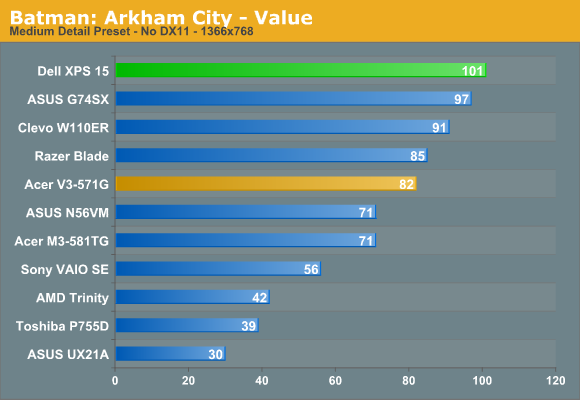

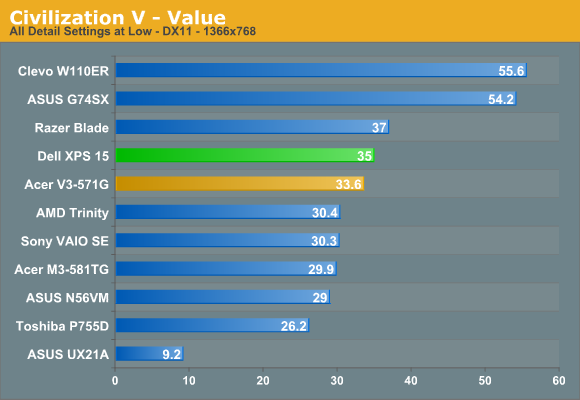

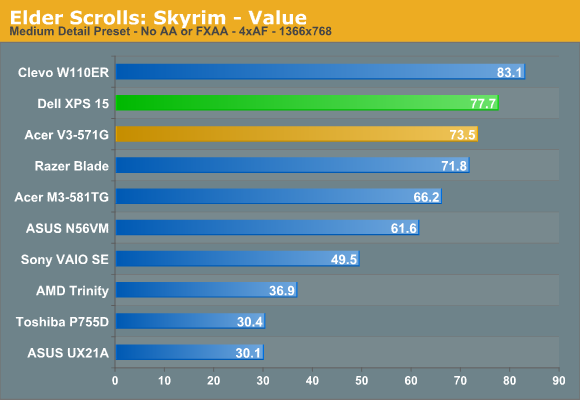
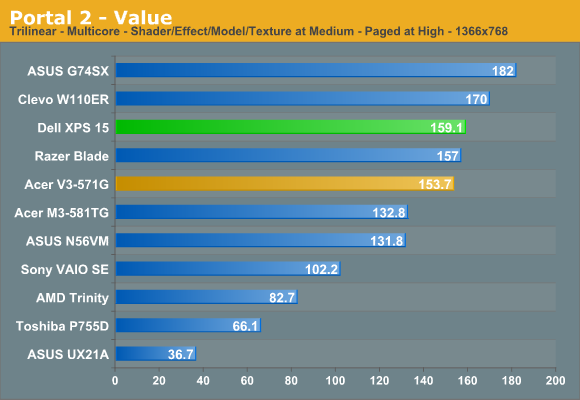
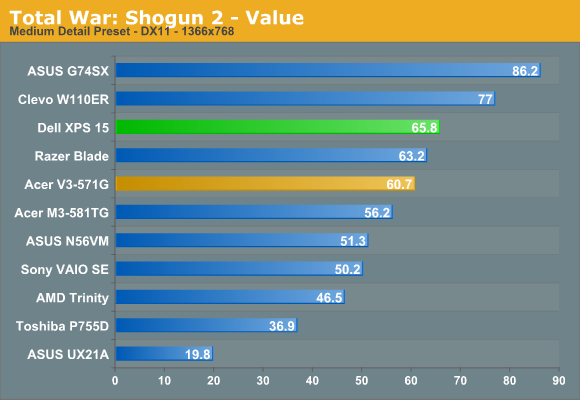
Our Value settings don’t pose any problem for the XPS 15, with all games easily besting 30FPS and most surpassing the 60FPS mark. The XPS 15 basically sweeps the table against the Acer V3, showing the value of using GDDR5 memory instead of DDR3 memory on the GPU. Also worth note is that Civilization V performance continues to be a bit quirky with certain driver versions; the original 296.01 drivers couldn’t even break 30FPS regardless of setting on the XPS 15, while the newer 304.79 beta drivers at least let you get 35FPS. One quick look at the W110ER results however shows that we ought to be able to get performance closer to 50FPS. I ran FRAPS while performing the Civ5 “lategameview” benchmark at one point to see what was going on, and for some reason performance appeared to fluctuate between 50FPS and 35FPS, where normally the frame rate is pretty steady. I’d guess a future NVIDIA driver will address the issue.
Mainstream Gaming Performance
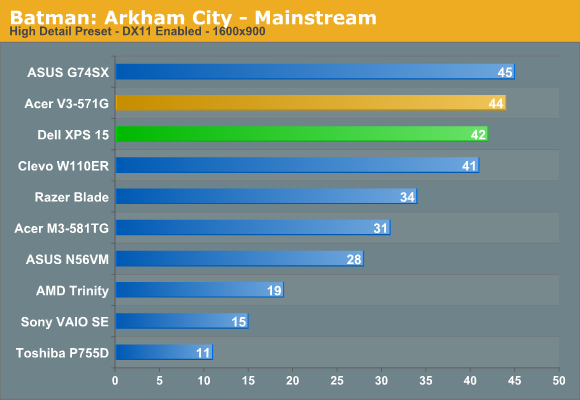
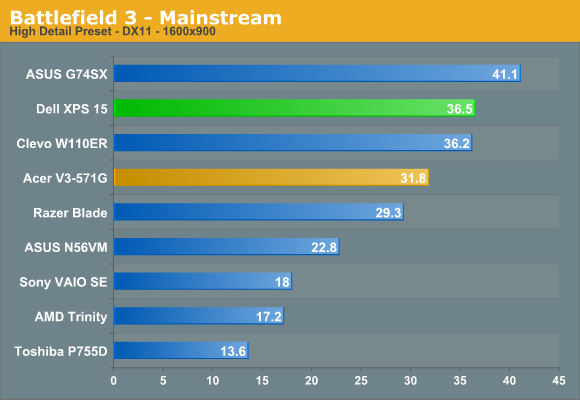
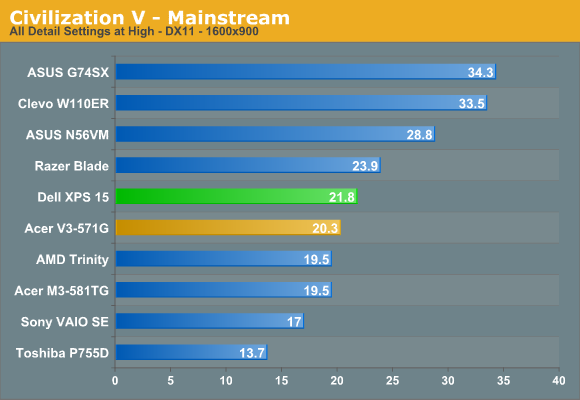
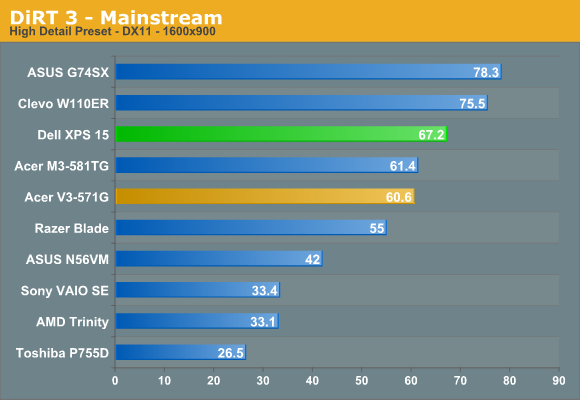
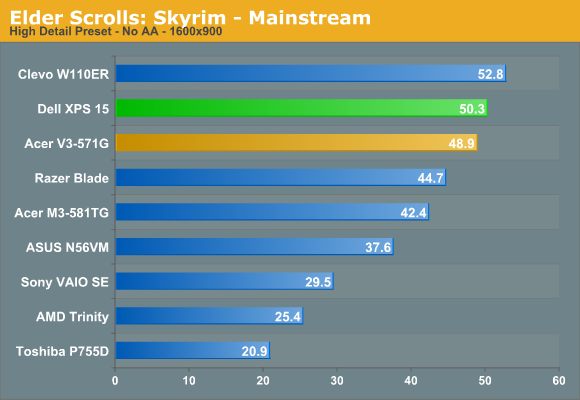
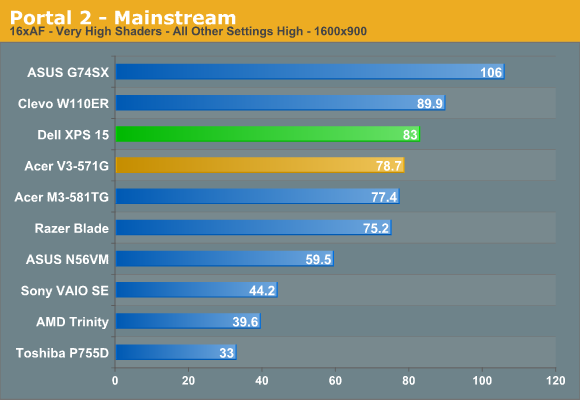

Mainstream performance generally follows the same pattern, only with lower frame rates. The GT 640M with GDDR5 is close to handling all of our test suite at 900p “High” details, with Battlefield 3 and Civilization V being the only two games where we’d recommend dropping to lower detail settings (and again, the drivers are likely a factor in Civ5 performance). It’s also interesting that the Acer V3 manages to eke out a win in Batman, indicating our lowered CPU clocks might be coming into play. Otherwise, the use of GDDR5 is typically able to improve GT 640M performance by an average of 8%, with up to 25% higher performance in at least one game (Batman using our Value settings).
|
Dell XPS 15 Gaming Recommended Settings for 1920x1080 |
|||
| Game | Detail | FPS | Notes |
| Batman: Arkham City |
Very High + 4xAA |
46 |
DX11 and PhysX both tend to be too much for the GT 640M, but you can max everything else out and maintain smooth frame rates. |
| Battlefield 3 |
Medium (“Value”) |
32.6 |
Single-player is okay at these settings, but multi-player will need to drop the resolution or use custom settings with some items on Low. |
| Civilization V | Low (“Value”) | 32.3 |
Civ5 needs a better driver, and we’ve seen higher scores in the past. Until then, setting everything to “Low” is your best bet for 1080p. |
| DiRT 3 | High + 4xAA | 45.8 |
Very fluid at the High defaults with 4xAA. If you try Ultra without AA, you’ll be closer to 30FPS. |
| Portal 2 | Max + 4xAA | 57.8 |
You can pretty much max out the settings in Portal 2 and still maintain fluid frame rates. |
| Skyrim | Ultra + 4xAA | 30.8 |
Skyrim is playable at 30FPS, and so our Enthusiast defaults work well enough. If you want slightly higher performance, you can use FXAA instead of 4xAA and get 35 FPS. |
| Total War: Shogun 2 |
High (“Mainstream”) |
34.8 |
The “High” preset seems to work best, though “Very High” with AA disabled is also viable. |
Most of the games’ settings are straightforward, but a couple warrant further explanation. In Batman, enabling Very High with PhysX is borderline playable, with an average frame rate of 27 FPS; DX11 without 4xAA is a similar 26 FPS, and enabling 4xAA in either mode drops a few FPS whereas FXAA is basically free. Civ5 performance is still a bit chaotic (see below), so take those scores with a grain of salt for now. Finally, our test scene in Skyrim happens to be one of the lowest performing areas we could find, so while we report 30 FPS there are many areas in the game that will run in excess of 60 FPS.
As mentioned earlier, Civilization V and Total War: Shogun 2 ran better with the most recent 304.79 beta drivers, and that’s what we used for the above settings. The remaining games all ran best with the official 296.01 Dell drivers, though at some point we expect to see a new WHQL driver that will provide the best of both worlds (and hopefully further improve Civ5 performance). Not shown in our charts is another popular game, Diablo III; given that the Acer V3 could handle maxed out settings, the same holds for the XPS 15. With GDDR5 memory, the GT 640M ends up being around 10% faster on average compared to DDR3; it can certainly handle gaming at 1080p, but in many games you’ll need to lower the detail settings somewhat to be fully playable.










109 Comments
View All Comments
CeriseCogburn - Sunday, July 29, 2012 - link
Looks like the truth is less than half on not so old macshttp://www.ebay.com/itm/Mac-Book-Pro-17-2-3Ghz-i7-...
BillatDell - Wednesday, July 25, 2012 - link
Very fair review, all things considered, Jarred. Thank you very much. I am the Dell employee you linked to out on Notebook Review Forums.I am wondering if skin temps matter to you and the Anandtech audience. I'd be curious to see a skin temp comparison under similar loads between the XPS and any competitive system, particularly the rMBP and MBP. It may not have any impact on anyone's buying decision if they don't see the numbers, but it may or may not matter to others if there turns out to be a wide disparity. Hard to tell if the cost/benefit analysis of our having a hard set skin temp spec across the board for all platforms stands to reason, given pretty much universal approval of how the MBP performs and the obvious lack of popularity with our current thermal/throttling scheme.
Anyone else have any thoughts on skin temps, or is it a non-factor? I'm interested to hear and get some thoughts out here on the record.
Great community. Great site. Thanks for all you do.
yyrkoon - Wednesday, July 25, 2012 - link
If I understand what you mean by "skin-temps" Bill. No for me personally it does not matter. The laptops I use currently serve as desktop replacements. As we are completely off-grid using solar, wind, and sometimes generators.However, I would admit. That we are not the norm for most users.
My own personal concerns are getting what I paid for but, stability first. Just for example. I like to play a lot of games, but have many computer related hobbies. So gaming performance for me tends to be my own benchmark. Of course I also have a price range I tend to stick within.
Unfortunately for me, and Dell. The XPS series is generally out of my own price range. However that could change. With that said, I have been keeping an eye on your companies products. Specifically the XPS mobile line.
JarredWalton - Wednesday, July 25, 2012 - link
Hi Bill, glad to have you on here. Skin (surface) temperatures are something I used to report, but them my thermometer broke and we added a couple more laptop reviewers and I figured I would just forget it and use internal temperatures. What I'd REALLY love to get is one of those digital thermal imaging cameras, but sadly they're a bit too much for me to convince Anand to buy a couple.As for what I think of skin temps, there's a balance that needs to be maintained, and certain areas can get hotter without bothering the user as much. If we're looking at a desktop replacement, it's not too big a concern, but for the more portable systems I definitely feel it's important. Ideally, I want the palm rest, keyboard, and the bottom "thigh" areas to be cooler, while the rear of the laptop (e.g. where the vent is on the XPS 15) can be hotter. 35C or less is generally what I'd like, but I live in WA so temperatures aren't as hot as, say, AZ or CA. If I were living in a hotter climate, I'd probably want even cooler running laptops.
Anyway, as you can probably glean from the review, I'd say you need stability as well as the ability to hit the rated performance on all parts. For the CPU, that means CPU clocks of 2.1GHz or higher regardless of workload should be possible pretty much indefinitely--and certainly if you're in a 75F or cooler environment. If the heatsink/fan can't keep the CPU and GPU at acceptable temperatures under load, then the hardware has been over-specced for the cooling. (We saw this exact same issue on Acer's TimelineX 3830TG, incidentally. Thin and light with reasonably fast hardware, but with gaming workloads the CPU would drop to 1.2GHz.)
My one thought that I keep coming back to on the XPS 15 is that it simply needs a higher RPM fan. Maybe the BIOS can kick the fan speed up one more level, but right now it just doesn't seem capable of cooling effectively at the current maximum RPM. A more drastic change would involve looking at the exhaust and trying to make that "breath" easier, as right now the bottom of the LCD/hinge seems to restrict airflow. Would either of these items be enough to fix the throttling problem? I don't know, but I am very surprised that this wasn't caught and addressed before retail units were shipping to the public.
Here's hoping we'll get a reasonable firmware fix in the near future!
Voldenuit - Wednesday, July 25, 2012 - link
OK, off the bat, I want to apologize for sounding like a broken record.But I was vocally unhappy with the Acer sporting a TN panel at $1400, and I'm even more unhappy with the Dell doing the same thing at $1700. What makes manufacturers think they could (or should) get away with foisting this sort of crap on people?
Next time I should just skip to the LCD page before reading any further. :/
Grok42 - Wednesday, July 25, 2012 - link
I agree. My preference of OS in order is Linux, Windows, BeOS, OS X. I also hate laptops as they are typically slower, hotter and cost more than a desktop. That said, as of today my next computer will probably be a rMBP because of the screen. My profession is computers and ~$1000 is nothing compared to what I will gain with a better tool with which to do my work. The PC industry better wake up and start offering multiple 4k displays or they are going to be wiped out.Doomtomb - Wednesday, July 25, 2012 - link
I like Dell and I want to see them succeed in the consumer/enterprise PC market. However, this review of the new 2012 Dell XPS 15 reminds me of the same niggles I had with my Studio XPS 16 purchased in early 2010. The one area that my Studio XPS 16 will always dominate is display (RGB-LED 1080p) displays colors perfectly unlike the XPS 15. Both of these computers are very premium products with price tags to match. The problems with the Studio XPS 16 were build quality (lousy hinges, seems between aluminum parts), heavy, battery life, and heat. It tries to push the boundaries between size, style, build quality, and performance but you can't have it all. It ended up being too big and heavy and just not quite as powerful as my friend's Alienwares. The battery life was also sub-par for class. I'd just rather recommend getting a thin and light, a gaming desktop replacement, or a MacBook with Retina Display.antef - Wednesday, July 25, 2012 - link
After the ridiculous overheating and throttling (to the point of an unusable machine) I've experienced with my Dell Precision, and reading this article with similar concerns, I can't imagine I'll be trusting a Dell for any high-performance workloads anytime soon.Death666Angel - Wednesday, July 25, 2012 - link
I was going to comment on how the MBP 15" gets mentioned in nearly every paragraph without being in the charts. Then I thought: "Well, they do have the Bench for those things." So I went there trying to compare this with the MBP 15" 2012. But you don't have the Dell there (yet) and you have no Apple 15" of any sort in there. How come? :-)tipoo - Wednesday, July 25, 2012 - link
Indeed, I'd like some macs on there